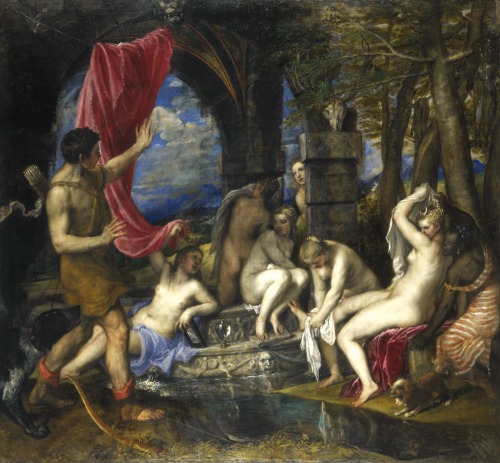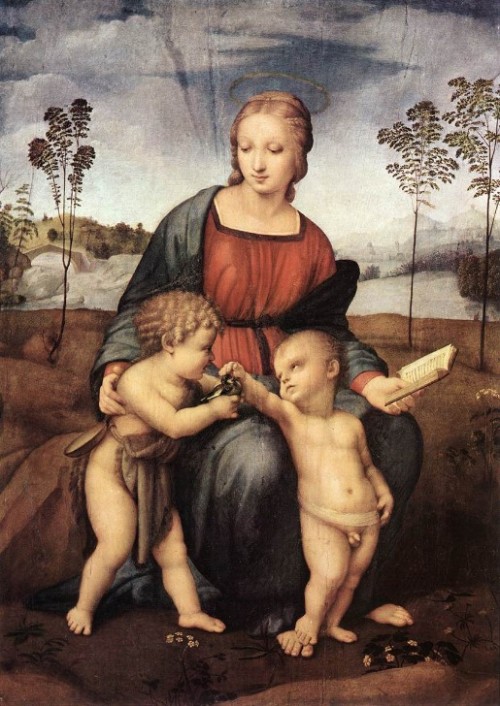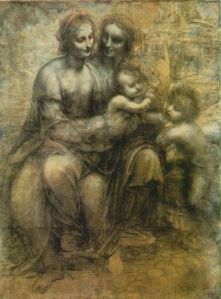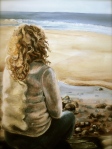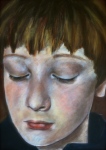Diana and Actaeon (1556-9), Titian: The Norwich Edition
Being somebody who is paid to teach children the very basics in literacy – with the most recent focus aptly being on those darned VCV words – AND something of a Renaissance-worshipper, the fact that I have been calling today’s featured artist ‘T-ee-tian’ – as opposed to the phonetically correct ‘T-i-tian’ – is no less than mortifying. I can only beg for your forgiveness and ask that you take me seriously for the rest of the impending spiel.
Norwich has undoubtedly upped its game in terms of artistic offerings. I mean a Titian, in sleepy, backward Norfolk – the communication black hole of the UK – amazing. (How did they physically organise this when the mobile phone reception and broadband connections are practically pre-historic?! ) But then, let’s be honest with ourselves, what else can one expect from the self-professed ‘Fine City’; the Venice of England? The painting itself, Diana and Actaeon was kindly on loan from the prestigious National Gallery, London to the more humble setting of the Castle Museum, Norwich. The Castle Museum is much loved by all in Norfolk, being a favourite destination for school trips, therefore the news of Titian’s attraction being temporarily housed inside those medieval walls filled me with unbridled happiness. I simply had to take a peak…
Diana and Actaeon (1556-9), Titian, Oil on canvas, 185.5cm x 202.2cm – courtesy of artfund.org
Determined to leave the masterpiece until last, I busied myself with the exhibition filler, which firstly provided a bit of background for Titian’s work; and secondly supplied alternative interpretations of Ovid’s great Metamorphoses. One of these alternatives was London-based photographer, Tom Hunter‘s recreation of the mythical scene, featuring a scantily clad Kim Cattrall. Classic Cattrall. Now I’m not really one for casual nudity but I must admit, however, that I did find the comparison between the attenuated figures of Hunter’s recent piece juxtaposed with the voluptuous forms of Titian’s age thoroughly engaging. A stark look at how the attitude towards beauty has undergone a dramatic transformation in the last 500 years.
As far as the background on the work was concerned, we were fed with the details on Titian and also the original poem that the piece had been derived from. For the benefit of those not so well-aquainted with the Roman poet, Ovid, I shall give a brief rundown of events. During a usual day’s hunt, Actaeon (just your everyday Roman chap) happened to stray from his hunting party. In doing so he stumbled across the secret bathing place of Diana, virgin goddess of the hunt, a most unfortuitous mishap. Now Diana, aka Artemis, did not take too kindly to this intrusion; so much so that she bestowed a wonderful punishment upon dear Actaeon, one that would involve his transformation into a splendid stag if he ever spoke again. For a huntsman, you can imagine that this would be quite inconvenient: the hunter taking the place of the hunted. Another lesson learnt for all of us there, courtesy of those barmy – almost wrote balmy there, whoops – Greeks. Saying that, the only lesson I can see here is that either Diana/Artemis was what some would call an ugly beast, therefore was inspired by humiliation to punish Actaeon; or more likely, Actaeon was not worthy to cast his eyes upon a beauty so divine, so pure that if he ever spoke of this encounter to anyone, it would be the last thing he ever did. Except for safety’s sake, Artemis extended the silence to any word that he spoke about anything, you know, just in case.
One of Actaeon’s hounds that would later turn on him, Diana and Actaeon (1556-9), Titian, Oil on canvas, 185.5cm x 202.2cm – courtesy of artfund.org
Once I had had my fill of the pre-painting palaver, I finally (and tentatively, for there was an oddly tense atmosphere surrounding the painting) sidled up next to an elderly lady who appeared to be the guardian of the painting. She was a heavily-cloaked creature whose nose was hovering mere inches away from the 450 year-old surface – as if sharing in a whispered secret from the oils themselves. Seeking to imitate this apparently satisfying method of painting perusal, I too peeked and craned as far as my little neck could manage from the spot I’d rooted myself to, near the left corner of the piece (I wasn’t as brave as the aforementioned dear in strolling casually in front of the painting, perhaps due to the bench of judging eyes behind me, regardless of how captivating the moue of Diana happened to be).
The painting itself was every bit as beautiful as I’d hoped. The highly saturated colours and angelic forms, painted with the utmost of grace and ease, are just two of the trademarks typical of the Venetian legend. Looking more closely at the colours present in the piece, we will notice that red is certainly one of the predominant shades, linking both protagonist and antagonist. We can interpret this to thus signify the impending bloodshed of Actaeon, as a result of his transgression against the divine lady. Next we turn to the periwinkle enshrouding one of the nymphs which, reflecting the true blue of the sky, we can interpret as a clear representation of the purity and femininity present within a crowd as chaste as this. These blue hues, paired with the crimson, present quite a startling contrast against the neutrality of the earthy sepia and ochre.
Close-up of nymph, Diana and Actaeon (1556-9), Titian, Oil on canvas, 185.5cm x 202.2cm – courtesy of artfund.org
One aspect of the piece I personally deem to be the most interesting is the inclusion of the black female tending to Diana, hastily tugging at the cloth to ensure the goddess regains her modesty due to being uncovered. One wonders why Titian made the decision to paint the female attendant amongst Diana’s naiad-like aides, and the resultant significance this had on the Renaissance world. This calls for a separate essay methinks… In addition, the interaction between the pup yapping furiously at the heels of Diana and the haggard hound belonging to Actaeon provides a great paradigm of hostility and affront: the overall themes of the piece.
Close-up of Diana and female attendant, Diana and Actaeon (1556-9), Titian, Oil on canvas, 185.5cm x 202.2cm – courtesy of artfund.org
On the whole, it was a great privilege to be able to view a genuine piece of Renaissance mastery, and at somewhere so close to home. But to the neatly placed comments book, inviting us to simper a grateful thanks for our stay at Hotel Titian, I must say no thank you. It’s true that the Castle Museum should be applauded for their efforts in managing to eke an entire exhibition out of this one great painting, however, I do not wish to kiss their medieval bottoms over it. Maybe that’s a bit harsh… One thing that did make me chuckle, though, were the twenty people clinging to the only seat in the room – as if walking around such a small exhibition required this agent of respite – appearing as an island of middle-age pretenders amongst a sea of Renaissance finery.
